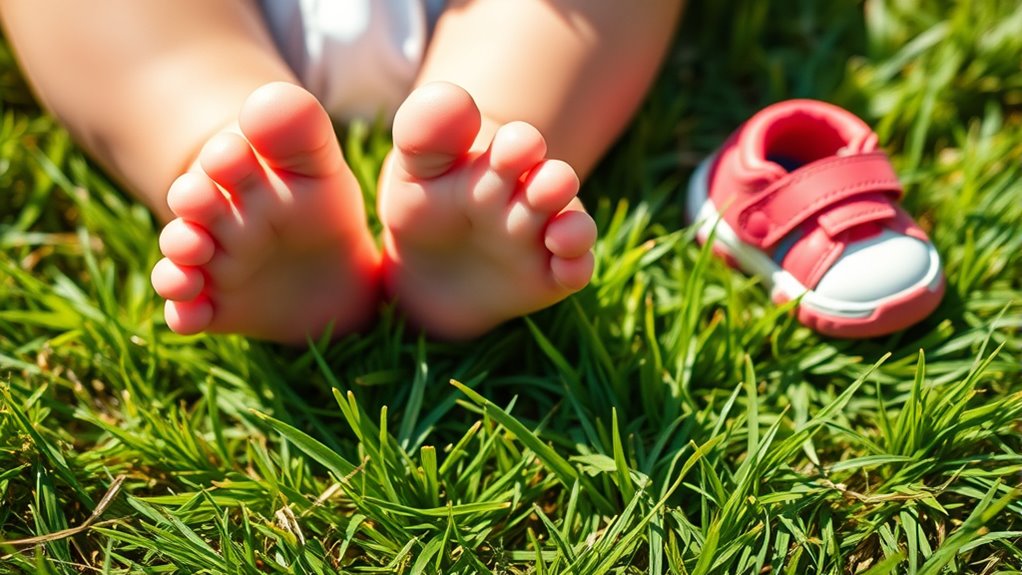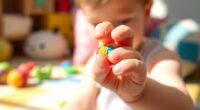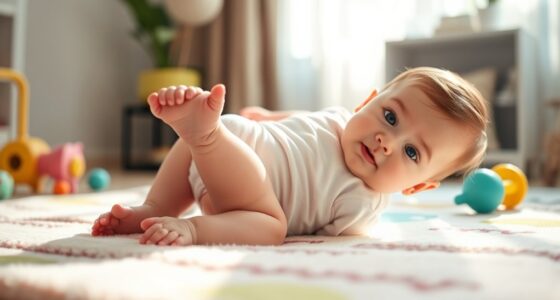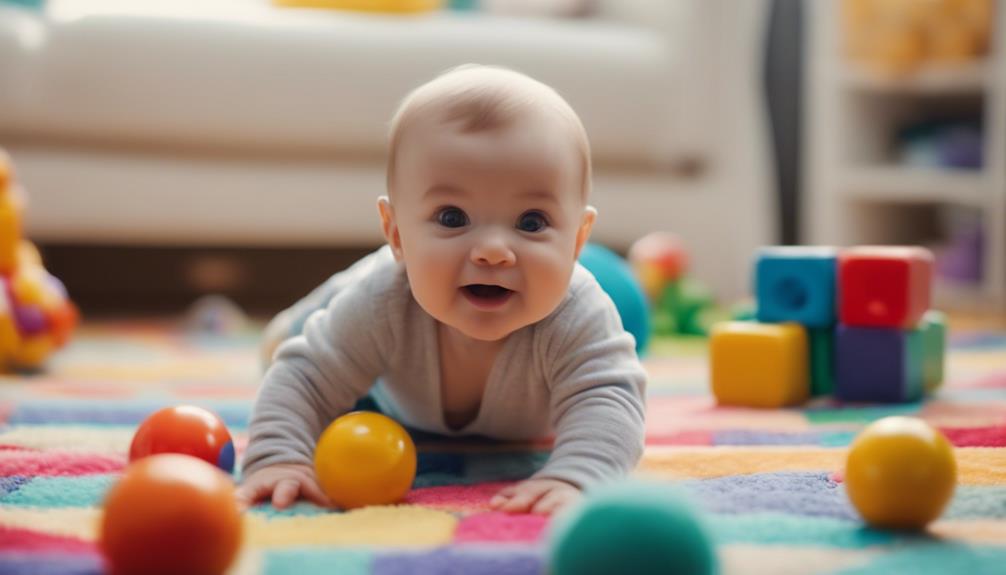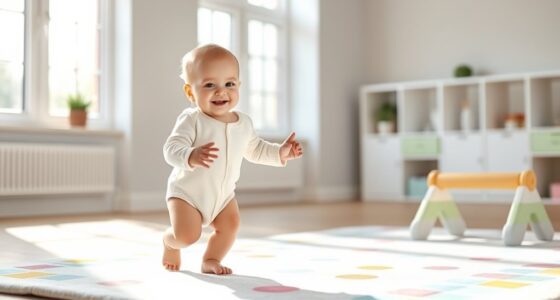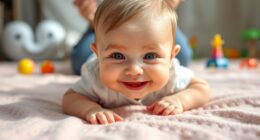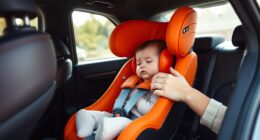Deciding whether your baby should learn to walk barefoot depends on balancing natural foot development with safety. Walking barefoot encourages healthy muscle growth, better balance, and natural gait, but protective footwear is essential outdoors or on rough surfaces. Opt for lightweight, flexible shoes that don’t restrict movement. By understanding when to let your baby explore barefoot and when to protect their feet, you can support confident, healthy walking—more tips ahead will help you make the best choice.
Key Takeaways
- Barefoot walking promotes natural foot development, strength, and better balance in babies.
- Protective footwear is essential for outdoor or unsafe surfaces to prevent injuries.
- A balance of barefoot time indoors and minimal, flexible footwear outdoors supports healthy growth.
- Hard or restrictive shoes can hinder proper arch formation and motor skills development.
- Choosing lightweight, flexible shoes that mimic barefoot conditions helps babies develop confidence and stability.
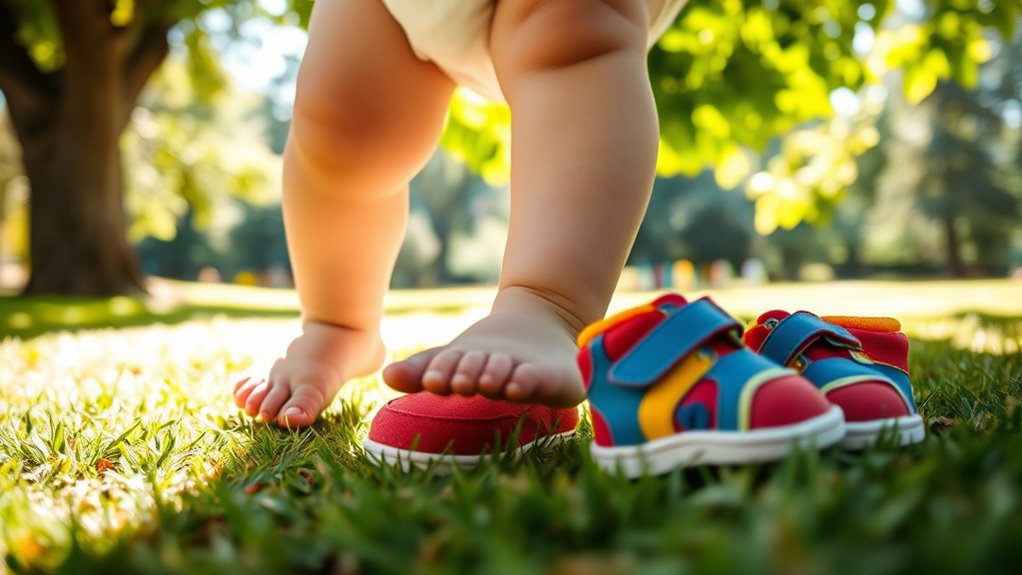
Have you ever wondered whether sneakers or dress shoes are better for everyday wear? When it comes to babies learning to walk, the choice between letting them go barefoot or providing supportive footwear is a common concern. Many parents worry about footwear safety, questioning whether shoes might protect their little ones from hazards or hinder their natural development. The debate often revolves around whether barefoot development is beneficial or risky, making it a tricky decision to navigate.
Walking barefoot allows your baby’s feet to develop more naturally. Without shoes, they gain direct sensory feedback from the ground, which helps strengthen tiny muscles and improve balance. This natural stimulation encourages proper foot arch development and enhances coordination, laying a strong foundation for future mobility. When you allow barefoot exploration, you’re supporting your child’s innate ability to adjust their gait and posture, which can lead to better overall stability. Plus, the tactile experience helps your little one build awareness of their environment, an essential part of their sensory and motor development.
On the other hand, footwear safety is a valid concern. Shoes can protect little feet from sharp objects, hot surfaces, and rough terrain that might cause injuries or infections. When you choose appropriate shoes, especially lightweight and flexible ones designed for infants, you’re providing a layer of defense without overly restricting movement. The right footwear can also prevent slips and falls, giving your baby confidence as they become more mobile. Remember, not all shoes are equal—hard-soled or overly restrictive shoes can actually limit foot flexibility and slow barefoot development, so selecting the right kind of footwear is vital. Additionally, footwear design that prioritizes flexibility and minimal structure supports natural foot movement.
The key is to strike a balance. During indoor play or on safe, even surfaces, letting your baby walk barefoot can promote healthy foot development. For outdoor adventures or rougher terrains, opting for footwear that’s lightweight, flexible, and offers good grip can protect their feet while still allowing natural movement. It’s essential to consider the environment and your child’s specific needs. Shoes should never be tight or overly structured, as they can interfere with barefoot development and cause discomfort. Instead, look for footwear that mimics barefoot conditions—thin soles, flexible materials, and ample room for toes to move freely.
Ultimately, your approach should prioritize safety without sacrificing natural development. Giving your baby regular barefoot time on appropriate surfaces supports their foot strength and sensory growth. When they do wear shoes, choose wisely to guarantee footwear safety and preserve the benefits of barefoot development. Finding this balance helps your little one learn to walk confidently and healthily, setting the stage for strong, healthy feet in the future.
Frequently Asked Questions
When Should Babies Start Walking Independently?
You might wonder when babies should start walking independently. Typically, most babies take their first steps around 9 to 15 months. During this time, you should consider footwear hygiene to keep their feet clean and healthy. Remember, parent preferences vary—some prefer barefoot walking to strengthen muscles, while others choose shoes for protection. Trust your instincts and consult your pediatrician for guidance tailored to your baby’s development and comfort.
Are There Specific Shoes Recommended for Early Walkers?
You might worry about finding the right shoes for early walkers, but comfort is key. Look for options that provide good flexibility, lightweight design, and a non-slip sole, ensuring your child’s shoe comfort. Brand recommendations like Stride Rite or Pediped often meet these criteria. Remember, the best shoes support natural foot development, so prioritize fit and function over style to help your little one walk confidently.
How Does Shoe Type Affect a Baby’s Foot Development?
You might notice that shoe type impacts your baby’s foot development, especially in foot arch development and shoe flexibility. Choosing shoes with good flexibility allows natural movement, supporting healthy arch formation. Stiff shoes can hinder this process, so opt for lightweight, flexible options that mimic barefoot walking. This helps guarantee your baby’s feet develop correctly, giving them the best foundation for walking and overall foot health.
Can Walking Barefoot Cause Injuries or Infections?
Imagine your little one exploring the garden barefoot, tiny toes gripping the ground. While walking barefoot can boost foot strength and aid injury prevention, it does carry risks like foot infections or cuts. To keep your baby safe, make certain the environment is clean and free of hazards. Supervised barefoot play helps build healthy feet without exposing them to unnecessary injury or infection.
What Are the Signs of Proper Foot Growth in Babies?
You’ll notice proper foot growth in your baby if their ankle flexibility improves without discomfort, allowing easy movement. Check that their toes are well aligned, not curled or overlapping, which indicates healthy development. As they grow, their feet should become stronger and more flexible, with no swelling or pain. Regularly observe their foot’s shape and movement, ensuring they develop the necessary strength and flexibility for walking confidently.
Conclusion
In the end, the choice is yours to make, like holding the reins of a delicate bird. Going barefoot allows your baby’s feet to breathe and develop naturally, giving them the freedom to explore like a curious kitten. Shoes can sometimes act like chains, stifling their early mobility. Trust your instincts and watch their tiny toes dance freely—after all, every step they take shapes their journey, just like a painter strokes a blank canvas into a masterpiece.

